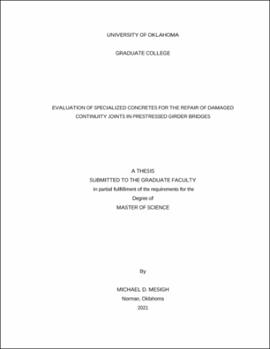| dc.description.abstract | Precast, prestressed concrete simple span girder bridges made continuous through the use of continuity joints exhibit a great, structural advantage when dealing with additional dead and live loading across the deck. Unfortunately, time-dependent effects such as temperature, creep, and shrinkage may cause the girders to camber upward and the continuity joint to crack. The crack in the joint can cause a loss of continuity and leaves the reinforcement within prone to corrosion damage. A potential solution to this problem is to repair the damaged continuity joint using specialized concretes such as ultra-high-performance concrete (UHPC), fiber-reinforced self-consolidating concrete (FR-SCC), and a magnesium aluminum liquid phosphate concrete (MALP), called Phoscrete®. These specialized concretes have been shown to perform better than traditional concrete. An extensive literature review of previous research has been done to gain an understanding of what the current state of continuity joint repair is in and where it should be heading. The main objective of this study was to provide an adequate continuity joint repair solution for in-service bridges showing deterioration from time dependent effects.
This research began by constructing and combining twenty-four half-scale, half-length AASHTO Type II bridge girders resulting in twelve girder-joint-girder specimens. Steel reinforcement within the continuity joint was based on previous research and adapted to the specific sizing of the specimens for this research. The specimens were tested under two different load cases – positive and negative moment bending. Three of the twelve girder-joint-girder specimens acted as the control group and tested to negative moment flexural failure. Observations and data for the load at failure, strain, and deflection were collected. The remaining nine specimens were initially loaded in positive moment bending until a crack began to propagate upward within the continuity joint. This crack simulated girder-joint-girder damage found in the field. Repairs using additional reinforcement and specialized concretes were constructed and tested. Six repair specimens’ moment capacities (two from each repair material) were determined in negative moment bending and three moment capacities (one from each repair material) were determined in positive moment bending. Once again observations and data for the load at failure, strain, and deflection were collected. The results from the tests were compared to the data from the control group and each other. These results indicated viable options for girder-joint-girder repairs in the field. | en_US |
